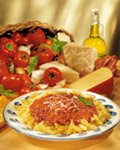
When I was living in China, ordering a dish of something coated in spicy garlic sauce was usually a gamble. Take pork or eggplant for example, two Sichuan dishes usually cooked with this sauce. The dish could be either perfectly manageable, or, if the chef was overly generous with his chili oil, throat-burningly spicy. Having your throat burnt isn't necessarily bad, per se (after all, you did go out for Sichuan). But when your meal also includes mapo tofu, dan dan noodles, and boiled beef in chili sauce, it would be nice to have a little reprieve.?
In the U.S., shrimp with garlic sauce in Chinese restaurants is rarely very spicy, even if the entree is marked with a big red star or chili pepper on the menu. I wanted to strike a balance with this recipe. Instead of using a lot of chili oil, like in Sichuan cooking, or a tiny squeeze of hot sauce like many restaurants here seem to do,? I used a good amount of Huy Fong (Red Rooster brand) chili garlic sauce instead. (You can use any brand of chili garlic sauce or regular chili sauce.)
Of course, because this dish is all about the garlicky taste, nothing beats freshly sautéed garlic. There is nothing wrong with adding garlic on top of garlic. You'll want to start with sautéing a few cloves cloves, crushed or chopped. Then add the shrimp and the sauce, and the entree will be done in, seriously, 5 minutes.?
_________________________
Shrimp with Spicy Garlic Sauce
Serves 4
1 1/2 pounds uncooked large shrimp
3 tablespoons soy sauce
2 tablespoons chili oil
2 teaspoons sesame oil
1 teaspoon sugar
2 tablespoons olive oil
3 gloves garlic, crushed or finely chopped
2 teaspoons Chinese rice wine
1 pinch freshly cracked black pepper
1 scallion, thinly sliced
1. Peel the shrimp, leaving the tail segments intact, then devein them.?
2. In a small bowl, mix together the soy sauce, chili oil, sesame oil, and sugar and set aside.
3. In a wok or large pan, heat the olive oil over medium-high heat. Stir-fry the garlic until fragrant, about 30 seconds. Add the shrimp and cook until both sides are pink, about 2 minutes on each side. Add the sauce mixture and stir so the shrimp is fully coated.
4. Remove from the heat and garnish with chopped scallions. Serve with rice or vegetables.
____________________________
More Chinese seafood recipes to try:
Dragon Well Tea Shrimp (Longjing Xiaren)
Ginger and Scallion Steamed Crab
Chinese Steamed Fish with Black Bean and Ginger Sauce
Coconut Milk Shrimp
Wonton Noodle Soup, Hong Kong-Style

 Spicy Chicken with Cashew Nuts pictures (1 of 3)
Spicy Chicken with Cashew Nuts pictures (1 of 3)













